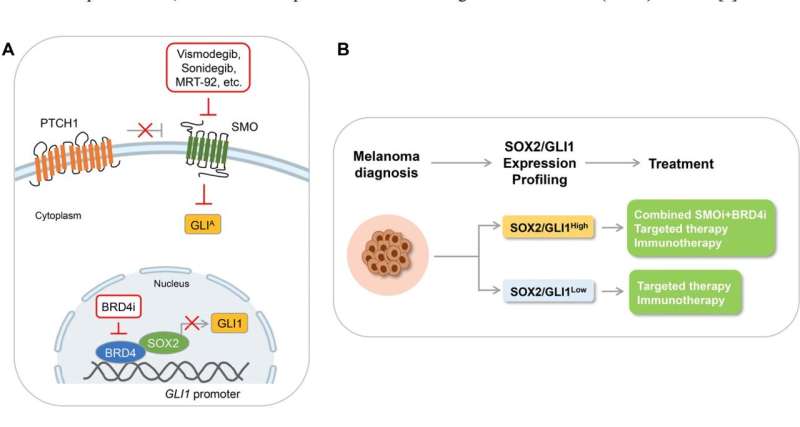Combined targeting of SMO and BRD4 as a potential therapeutic strategy against melanoma. Credit: Oncotarget (2023). DOI: 10.18632/oncotarget.28441
A new editorial paper titled "Combined targeting of HEDGEHOG signaling and BRD4 as a novel therapeutic option against melanoma" has been published in Oncotarget.
The Hedgehog-GLI (HH/GLI) pathway is aberrantly activated in several types of cancer. Canonical HH/GLI pathway is triggered by binding of HH ligands to the twelve-pass transmembrane receptor Patched 1 (PTCH1), which retrieves its inhibition on the seven-pass transmembrane G protein-coupled receptor Smoothened (SMO), leading to the activation of the GLI transcription factors. Small molecules inhibitors targeting the essential pathway transducer SMO (e.g., vismodegib, sonidegib) have demonstrated therapeutic efficacy in HH-dependent tumors, such as basal cell carcinoma (BCC) and medulloblastoma (MB).
However, the therapeutic efficacy of these SMO antagonists is limited by the development of acquired resistance and recurrence after drug withdrawal, and by additional oncogenic signals responsible for non-canonical activation of GLI transcription factors.
In this new editorial, researchers Silvia Pietrobono and Barbara Stecca from the University of Verona and the Institute for Cancer Research and Prevention (CRL-ISPRO) state that they subscribe to the idea that targeting non-canonical HH/GLI signaling will improve the response rate and durability of therapeutic effects exerted by SMO inhibition. Therefore, they propose that the identification of novel targetable regulators that function downstream of SMO, especially those acting at the transcriptional level, is of critical importance to effectively inhibit the HH pathway and prevent tumor relapse.
"Collectively, the findings presented by Pietrobono et al. pave the path for the development of a novel therapeutic strategy in tumors having both canonical and non-canonical HH/GLI signaling activation, such as melanoma," the paper concludes.
More information: Silvia Pietrobono et al, Combined targeting of HEDGEHOG signaling and BRD4 as a novel therapeutic option against melanoma, Oncotarget (2023). DOI: 10.18632/oncotarget.28441
Journal information: Oncotarget
Provided by Impact Journals LLC
























